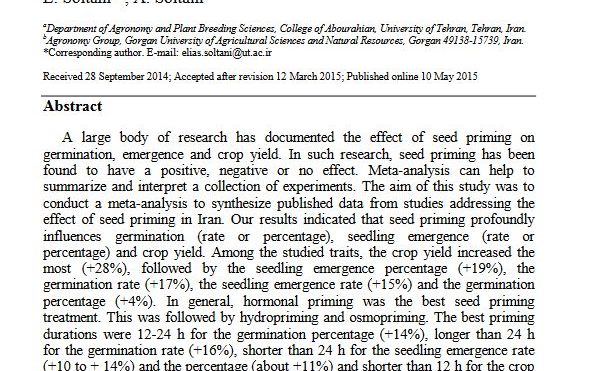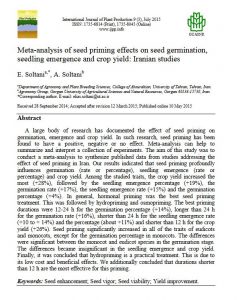A large body of research has documented the effect of seed priming on germination, emergence and crop yield. In such research, seed priming has been found to have a positive, negative or no effect. Meta-analysis can help to summarise and interpret a collection of experiments. The aim of this study was to conduct a meta-analysis to synthesise published data from studies addressing the effect of seed priming in Iran. Our results indicated that seed priming profoundly influences germination (rate or percentage), seedling emergence (rate or percentage) and crop yield. Among the studied traits, the crop yield increased the most (+28%), followed by the seedling emergence percentage (+19%), the germination rate (+17%), the seedling emergence rate (+15%) and the germination percentage (+4%). In general, hormonal priming was the best seed priming treatment. This was followed by hydropriming and osmopriming. The best priming durations were 12-24 h for the germination percentage (+14%), longer than 24 h for the germination rate (+16%), shorter than 24 h for the seedling emergence rate (+10 to + 14%) and the percentage (about +11%) and shorter than 12 h for the crop yield (+26%). Seed priming significantly increased in all of the traits of eudicots and monocots, except for the germination percentage in monocots. The differences were significant between the monocot and eudicot species in the germination stage. The differences became insignificant in the seedling emergence and crop yield. Finally, it was concluded that hydropriming is a practical treatment. This is due to its low cost and beneficial effects. We additionally concluded that durations shorter than 12 h are the most effective for this priming.
Region: Iran
Date published:
2015
Published by:
International Journal of Plant Production
Type of resource:
Journal article
Resource topic:
Seed priming, Seeds
Project/Programme: Not specific
Pest/Disease: Not specific
Pages:
21
File type:
External link (540 KB)




